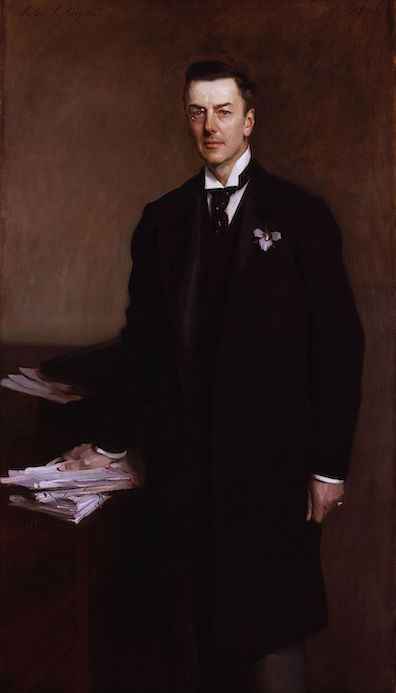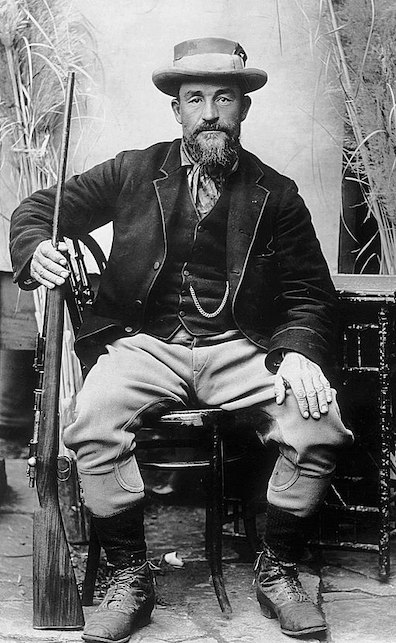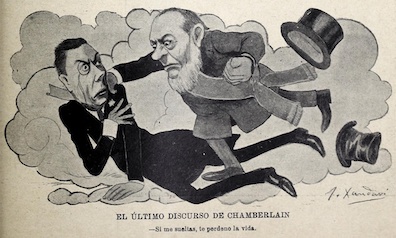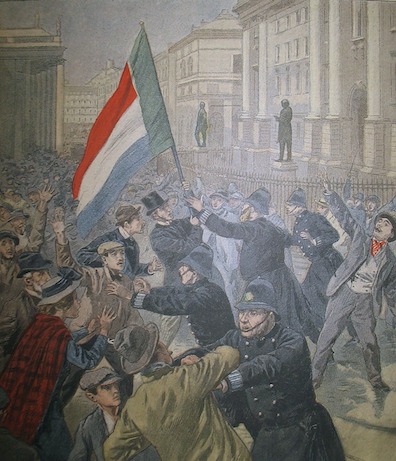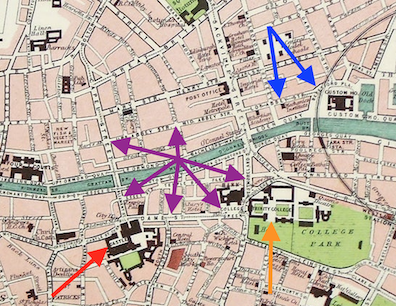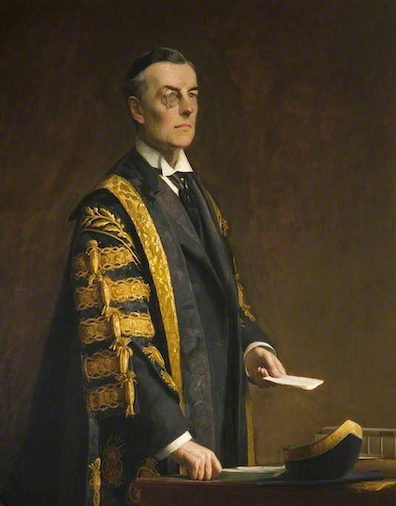In Lestrygonians Bloom watches two squads of
constables near the "Trinity railings," site of a
confrontation between policemen and protesters of
Chamberlain's visit that soon moved west to Dublin Castle, and then
north across the Grattan Bridge. Bloom recalls being caught up
in the violence that erupted at the far end of this turbulent
procession, and the angry shouted protests: "— Up the
Boers! / — Three cheers for De Wet! / — We'll
hang Joe Chamberlain on a sourapple tree." Christiaan de
Wet was a general in the citizen army of the Boers who became
its foremost practitioner of guerilla warfare. He returns in Circe,
as does the reviled Joe Chamberlain.
Chamberlain had been despised in Ireland since 1886.
Ferociously antagonistic to Gladstone's plans for Home Rule,
he helped defeat that legislation and resigned from the
Liberal Party, causing its government to fall. His new party,
the Liberal Unionists, formed an alliance with the
Conservatives, and when this bloc came to power in 1895 he was
given the office of Secretary of State for the Colonies.
Although he had once been outspokenly anti-imperialist, he
used his new position to pursue an aggressively militaristic
policy toward the Dutch republics in South Africa and
effectively directed the war effort from London. At first the
war went badly for the British: the towns of Ladysmith,
Mafeking, and Kimberly were besieged, and large battles at
Stormberg, Magersfontein, and Colenso were lost in the short
span that came to be known as Black Week. The Irish, who knew
a thing or two about imperial suppression of small republican
nations, greeted the dark news with unbridled joy.
Chamberlain fought opposition to the war with persuasive
speeches in Parliament, with personal attacks on Liberal
politicians whom he cast as all but traitors, and with a trip
to Dublin that many people supposed was designed to show
Ireland's support for the war effort. If this was indeed his
intention, it was a terrible miscalculation. Even before the
start of hostilities Irish nationalists were enlisting to
fight on the side of the Boers in a unit called the Irish
Transvaal Brigade led by Major John MacBride—one of three
Easter Rising leaders executed in 1916 who had fought in South
Africa. After returning from South Africa, where he had worked
in the Transvaal mines from 1896 to 1898, Arthur Griffith worked to form
a political counterpart called the Irish Transvaal Committee,
which was housed in an office on Lower Abbey Street that in
1900 birthed Cumann na nGaedheal, the precursor of Sinn Féin.
Nationalist leaders affiliated with the ITC, including
Griffith, Maud Gonne,
Michael Davitt, the young socialist organizer James Connolly
(also executed in 1916), and the old Fenian leader John O'Leary
planned a pro-Boer protest rally in Beresford Place, not far
from Trinity College and site of another pro-Boer
demonstration on 1 October 1899 that drew 20,000 people. The
authorities planned a massive police response. The resulting
turmoil put paid to any notion that the Irish public largely
supported the British imperial program.
In a book titled Forgotten Protest: Ireland and the
Anglo-Boer War, 2nd ed. (Ulster Historical Foundation,
2003), the Durban-based historian Donal P. McCracken provides
a lively summary of the Chamberlain protest, starting with the
effect that news of British military setbacks had on
Dubliners: "The crowds would thrill with excitement and men,
radiant with delight, would stop strangers in the street and
express their pleasure. Dublin witnessed scenes akin to those
which were to take place in London when Mafeking was
relieved." (Stephen refers in Scylla and Charybdis to
the huge "tide of Mafeking enthusiasm" released in
England when the siege of that town was lifted.) According to
the Freeman's Journal,
"In two brief months, the bravery of the little people has
destroyed the military prestige of the British Empire,
demoralized their troop of enemies, and amazed the world with
the spectacle of what men who prefer death to the destruction
of their nationality can accomplish" (53).
With the news that Chamberlain would be visiting Dublin to
receive an honorary degree on Monday, December 18, plans were
hatched to hold a protest rally in Beresford Place on Sunday,
December 17. On Saturday the authorities in Dublin Castle
issued a proclamation banning the gathering. Griffith threw
his copy into the fireplace. Hundreds of policemen were
deployed on the streets beginning at 11 AM the next day, and a
large force of mounted police armed with sabers was assembled
in the courtyard of the Castle as a reserve force. At about
noon "a brake, or long car," pulled up outside the office of
the Irish Transvaal Committee and at least a dozen leaders
including O'Leary, Griffith, Gonne, and Connolly got in.
Connolly took the reins and "smashed the brake through a
police cordon to get into Beresford Place. The brake was
followed by a mass of people waving Boer flags and cheering
for the Boers" (54-55).
The occupants of the car were briefly arrested, but upon
their release from a nearby police station the brake, followed
by a huge crowd, crossed the O'Connell Bridge, went up
Westmoreland Street, and assembled on College Green outside
the "railings" of Trinity College—the spot where Bloom
thinks in Lestrygonians, "Right here it began."
Police attacked with batons drawn, forcing the crowd to move
west along Dame Street. After speeches and tauntings of the
policemen at points along the way, the crowd came to the end
of the street, where, since it seemed lightly guarded,
Connolly proposed capturing Dublin Castle. Cooler heads
prevailed—fortunately, since hundreds of armed horsemen were
still assembled in the courtyard, unseen. The brake and its
attendant crowd moved north, down Parliament Street toward the
river, followed by the mounted police who had issued from the
Castle after they passed.
When the crowd was across the Grattan Bridge, the officer in
charge ordered his men to charge with sabers drawn. "What
followed was one of the most violent scenes Dublin had
witnessed in a generation. A pitched battle took place . . .
It is said that Arthur Griffith disarmed a mounted policeman.
After the initial shock of the first charge—the police used
the flats of their swords—the crowds retaliated by throwing
whatever they could find. The mounted police were joined by
constables on foot, wielding batons. In the confusion the
brake escaped along Capel Street and turned into Upper Abbey
Street. It is interesting to find that Maud Gonne makes no
mention of this riot in her autobiography" (56).
Back at the office on Lower Abbey Street, "a packed and
jubilant meeting was held," though Davitt was fearful that Joe
Chamberlain might be attacked. McCracken concludes, "The day
was a victory for both sides. From the point of view of the
authorities, they had stamped on a major threat to their
control of the city. It was no accident that Dublin
experienced no more pro-Boer demonstrations of this magnitude.
The police had shown their determination to stand no nonsense.
In the short term, though, the victory was with the Irish
Transvaal Committee. Its prestige now soared in the minds of
many. It was widely, and most likely correctly, believed that
Chamberlain's real motive for visiting Ireland was to
'identify Ireland with the war.' The events of that Sunday
afternoon cast strong doubts on the success of such a mission.
. . . / In fact Chamberlain's visit was a political and
security blunder of the first magnitude . . . no amount
of cheering from the undergraduates of Trinity College could
disguise the psychological victory which the Irish Transvaal
Committee had won" (56-57).
In Lestrygonians Bloom recalls running from the
mounted police, only to see one of them fall from his horse:
"That horsepoliceman the day Joe Chamberlain was given his
degree in Trinity he got a run for his money. My word he did!
His horse's hoofs clattering after us down Abbey street.
Lucky I had the presence of mind to dive into Manning's
or I was souped. He did come a wallop, by George. Must have
cracked his skull on the cobblestones." This detail, confirmed
by contemporary accounts, places Bloom near the climactic
battle that engulfed the quays and Capel Street, at a time
when citizens were desperately fleeing the mayhem. (Manning's
pub was at 41 Upper Abbey Street, on the corner of Liffey
Street.) Had he wandered west from the newspaper offices near
O'Connell Street, or did he join the protest somewhere on its
route from Trinity College to Capel Street?
Wherever his involvement started, it seems that an accidental
encounter with some TCD students brought it about: "I
oughtn't to have got myself swept along with those medicals.
And the Trinity jibs in their mortarboards. Looking for
trouble. Still I got to know young Dixon." Joyce
modeled "young Dixon" on a real-life Joseph F. Dixon who
received a medical degree from TCD in December 1904, so
presumably the other "medicals" Bloom thinks of were also
attending that Protestant ruling-class institution. Slote,
relying on Patridge's dictionary of slang, identifies "jibs"
as first-year undergraduates. It is almost inconceivable that
any Trinity students, much less freshmen, would have been
demonstrating against Chamberlain. There are no contemporary
accounts of them doing so, and it is well known that some did
mount pro-Chamberlain rallies, so the students with whom Bloom
got "swept along" must have been "Looking for trouble" in the
form of violent confrontations with the mostly Catholic
nationalists.
However Bloom may have come to be swept up in the chaos, the
way he praises the great
many Irishmen who fought in the British armed forces
when accosted by two policemen in Circe suggests that
he feels defensive about having held pro-Boer,
anti-Chamberlain views. Bloom tells the constables that his
father-in-law fought in "the heroic defense of Rorke's drift,"
an 1879 action in Zululand, but his sycophancy is met with an
anonymous jeer: "Turncoat! Up the Boers! Who booed Joe
Chamberlain?" In reply, he makes himself a veteran of
the Boer War: "I'm as staunch a Britisher as you are, sir. I
fought with the colours for king and country in the absentminded war under
general Gough in the park and was disabled at Spion Kop and
Bloemfontein, was mentioned in dispatches." Sir Hubert Gough
helped lift the siege of Ladysmith in February 1900. Spion Kop
was the site of a Boer victory in January 1900. Bloemfontein,
the capital of the Orange Free State, fell to the British in
March 1900.
Erected in 1907, the notorious Fusiliers' Arch that guards
the Grafton Street entrance to St. Stephen's Green embodies
the contrary emotions expressed in Bloom's defensive rant to
the constables. It commemorates the courage and sacrifice of
four battalions of Royal Dublin Fusiliers in the Second Boer
War, with inscriptions recording the major battles in which
the Fusiliers took part and the names of the 222 men who died.
Nationalists, however, quickly bestowed a new name on it:
Traitors' Gate, the water entrance through which political
prisoners were long ferried into the Tower of London.
Remarkably, this triumphal arch remains, in McCracken's words,
"one of the few British-erected monuments in Dublin which have
not been blown up" (148).
